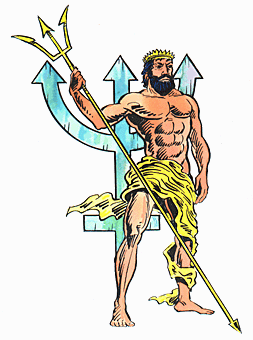The Planet Neptune
Neptune, Roman god of the sea
(eighth planet from the sun).

An ocean god for an ocean-colored planet.

- Astronomers use Neptune’s fishing spear, the trident, for the planetary symbol.
- Neptune is the Roman equivalent of the Greek Poseidon, god of the sea.
A few scientific facts about Neptune:
- Neptune had to wait until modern times to have a planet named in his honor.
- In the early 1800’s, astronomers carefully observed the planet Uranus in order to determine its exact orbit around the sun.
- They found to their surprise, that its actual movement lagged a bit behind what their calculations were predicting.
- In 1820, French astronomer Alexis Bouvard began making tables predicting the movements of Jupiter, Saturn, and Uranus.
- The tables seemed to work for Jupiter and Saturn, but he found it impossible to predict where Uranus should be.
- Some believed there might be another planet beyond Uranus whose gravitational pull was slowing it slightly.
- An English astronomer, John Couch Adams, and a French astronomer, Urbain J. J. Leverrier, unknown to each other, both calculated where such a planet must be to account for the effect on Uranus.
- They both came out with the same results: Leverrier was the first to announce his results and on September 23, 1846, Johann Galle, in Berlin, confirmed the existence of a new planet, less than one degree from the predicted position and, behold, there was the eighth planet.
- It was named Neptune, not for any particular reason, but because Neptune was one important god who did not have a planet named in his honor.
- Neptune is another gas giant, similar in size and structure to Uranus.
- Although discovered in 1846, the eighth planet will not return to the position where scientists first saw it until 2011.
- Neptune orbits slowly because it is far from the Sun.
- In size and color, Neptune seems to be a twin to Uranus, but Neptune does not spin on its side; its axis tilts only a little more than that of Earth.
- The orbits of two moons, Triton and Nereid, crisscross the equator diagonally.
- Between Triton, the largest satellite, and the planet itself, six small, recently discovered moons also orbit.
- The planet is about seventeen times more massive than Earth.
- Astronomers now regard Neptune and Uranus as twin planets, somewhat alike in size, density, mass, and rotation.
 You may return to the page of planet images from here.
|